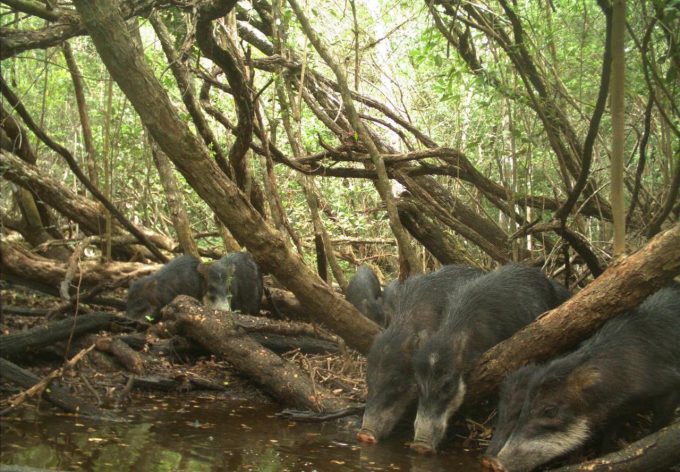In Mexico’s southern jungle, stretching across the Yucatán peninsula and into Guatemala, a group of white-lipped peccaries (Tayassu pecari) move from drinking hole to drinking hole. In the recent past, however, their task has been made increasingly difficult by the onset of climate change as over a ten year period between 2005 and 2015, available water sources reduced by an estimated 90% in the region.
Notwithstanding these increasingly long dry periods and groundwater scarcity in the southern jungle, these wild pigs somehow seem to find their way, causing biologist Rafael Reyna-Hurtado to theorize that perhaps they, like elephants, navigate the landscape using spatial memory. Elusive, shy and yet highly social among themselves, the peccaries’ movements orbit around water sources, specifically the ponds that intersperse the southern jungle, but their range extends across Central and South America.
Reyna-Hurtado first came across these ungulates in this sprawling tropical forest of nearly 54,000 square kilometers while doing postgraduate research on tropical deer with the University of Florida. “One day, when I was in the forest, in the tropical forest, I met a group of 72 peccaries,” he says, “and in that single moment I decided to switch my research to them.”
Despite having spent three years doing research on deer in the area, Reyna-Hurtado had never before encountered peccaries. That day, as he made the instinctive decision which was to alter the direction of his career, a number of questions popped into his head: Why had he not seen them before? Where were they coming from, and where were they going? How did they navigate the vast jungle?
Now, fifteen years later, Reyna-Hurtado’s research, having been featured internationally in documentary films and the likes of National Geographic, has come to suggest that peccaries do indeed move about the landscape using spatial memory. As water sources specific to groups dry up, the peccaries become desperate and distressed, going so far as to venture into human communities in search of water.
With these climate fluctuations of recent decades and in particular extended dry periods, the historical range of white-lipped peccaries has dwindled by an enormous 87% in the seven nations of Mesoamerica. Consequently, many of the local populations are facing precipitous decline as groundwater recedes, alongside human population growth and increased activity that fragments forests.
Though often neglected in the conservation movement in favor of more emblematic animals like big cats and monkeys, peccaries’ sensitivity to both climate change and human development makes them an important indicator species. The lack of empirical study at a regional perspective makes it difficult to gauge their population and habits—in Mesoamerica, it’s estimated there’s anywhere between 6,000 to 54,000 white-lipped peccaries.
“When the humans colonize a new area, the first species to disappear are the peccaries,” says Reyna-Hurtado. “What we learned is that for them to survive, they must have fixed and reliable water sources.”
It is that colonization — the construction of communities, transportation and agricultural facilities, for example — that poses an existential threat to peccaries. Large-scale developments like the Tren Maya, a 950-mile train planned to shuttle tourists across the Yucatán peninsula, as well as ever-increasing demand for agricultural operations such cattle ranching and soybean and palm oil plantations, continue to reduce the increasingly limited habitat for these creatures. Even if peccary groups succeed in remaining intact, human activity isolates populations into smaller areas, and such isolation doesn’t just restrict the range of mammals like peccaries, it also necessarily minimizes genetic exchange between groups.
To combat that fragmentation, Reyna-Hurtado has raised the idea of developing networks and wildlife corridors between the protected forests of Mesoamerican nations. As for forested lands that aren’t protected, he says encouraging communities to engage in low-impact economic activities, like honey collecting or sustainable forestry, and provide certificates that indicate sustainable production so as to augment biodiversity and curtail any of its loss. In addition, setting aside local ponds, especially those highly-trafficked by peccary groups and others, would further protect the ecosystem and its inhabitants.
The situation is a complicated uphill battle as the relative economic potential of monocultural products like beef and soy — and income from tourism — makes development attractive to economically marginalized communities. Further, private interests push projects that prioritize profit over preservation, in turn disproportionately impacting indigenous communities who consistently advocate for environmental protection and sustainable agriculture.
“Really, it’s an almost impossible task,” Reyna-Hurtado said. “We need to imagine that society can change all together, at once, but I guess if there is an upside to the pandemic it’s that we have learnt that immediate, structural change is possible.”
If society can see climate change as an immediate threat in the way we see the coronavirus pandemic, Reyna-Hurtado believes we can protect our forests and the biodiversity within. Although it may be a herculean task that requires a shift in how society allocates and consumes land and resources, doing so would foster healthy, transnational ecosystems that shelter, protect and provide for all sorts of species, from the emblematic jungle cats to the tapirs to deer to — of course — the quiet, shy, community-loving white-lipped peccary.
For The Yucatan Times Wildlife
Henry Haney
—
Henry Haney is a freelance writer based in North Carolina who writes stories with a particular focus on community environmental issues.



